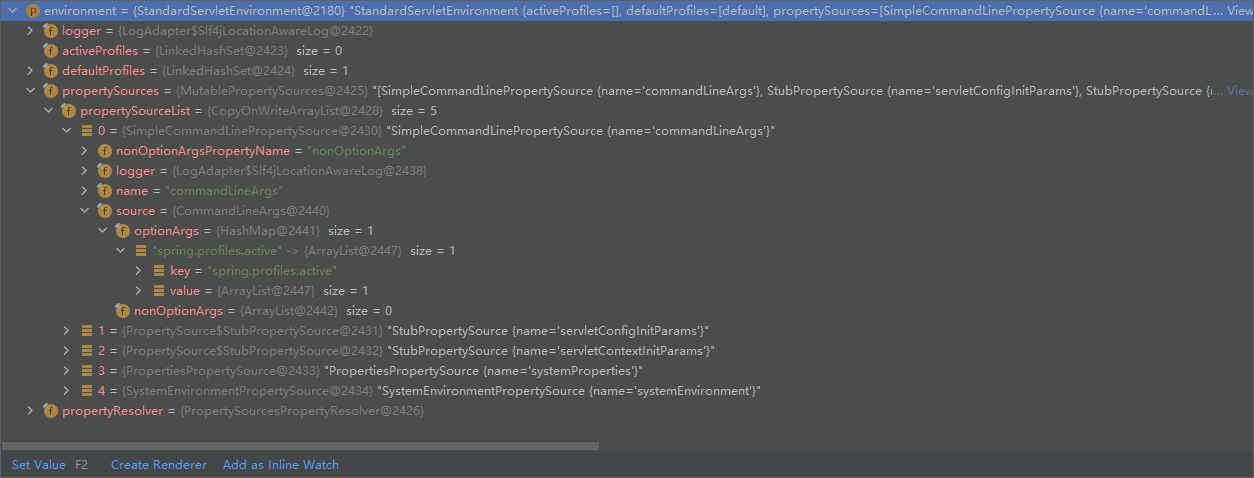04、SpringBoot 启动 准备运行环境(prepareEnvironment)流程(一)
目录:Springboot源码学习目录
上文:03、SpringBoot 启动 执行SpringApplication的run方法 准备运行环境前 流程
前言:
一、准备运行环境方法(prepareEnvironment)
private ConfigurableEnvironment prepareEnvironment(SpringApplicationRunListeners listeners,
DefaultBootstrapContext bootstrapContext, ApplicationArguments applicationArguments) {
// 获取配置环境对象 见下文标题二
ConfigurableEnvironment environment = getOrCreateEnvironment();
// 对配置环境对象进行相应属性初始化 见下文标题三
configureEnvironment(environment, applicationArguments.getSourceArgs());
// 检查环境对象中有没有 名字为 configurationProperties 的配置源,如果有就删除掉,然后创建一个放在第一个位置,见下文标题四
ConfigurationPropertySources.attach(environment);
// 发送环境准备完成事件(environmentPrepared),对环境配置环境对象进行增强
// 其中主要的就是EnvironmentPostProcessorApplicationListener监听器,配置文件的加载和解析都在这个监听器中完成
// 该步也是准备运行环境的核心步骤,其他步骤都可以不看,无关紧要,但该步是最重要的,我们放到下一篇文章讲解
listeners.environmentPrepared(bootstrapContext, environment);
// 移动名称为defaultProperties的属性源到最后面,使其成为配置文件对象中的最后一个源,见下文标题五
DefaultPropertiesPropertySource.moveToEnd(environment);
// 将环境对象绑定到当前Spring应用(SpringApplication),见下文标题六
bindToSpringApplication(environment);
// 判断是否为定制环境,如果是,将该环境对象转换为StandardEnvironment类型
// 默认情况下不是定制环境(isCustomEnvironment = false),一般走到该步骤环境对象为StandardServletEnvironment类型
if (!this.isCustomEnvironment) {
environment = new EnvironmentConverter(getClassLoader()).convertEnvironmentIfNecessary(environment,
deduceEnvironmentClass());
}
// 再次检查环境对象中有没有 名字为 configurationProperties 的配置源,如果有就删除掉,然后创建一个放在第一个位置,见下文标题四
ConfigurationPropertySources.attach(environment);
return environment;
}
二、获取配置环境对象
private ConfigurableEnvironment getOrCreateEnvironment() {
// 判断当前Spring应用中有没有环境属性,如果有直接返回,我们这是第一次启东应用,此时是没有的
if (this.environment != null) {
return this.environment;
}
// 前面实例化SpringApplication是,推断并初始化了webApplicationType属性,值为SERVLET
switch (this.webApplicationType) {
case SERVLET:
return new StandardServletEnvironment();
case REACTIVE:
return new StandardReactiveWebEnvironment();
default:
return new StandardEnvironment();
}
}
三、对环境对象进行赋值
在该步骤之直接我们先看一下debug截图中环境对象有哪些属性源

一个servlet配置属性源,一个servlet上下文属性源,一个操作系统环境变量属性源,一个jvm环境变量属性源
然后我们开始执行
protected void configureEnvironment(ConfigurableEnvironment environment, String[] args) {
// environment向环境对象中设置一个转换器
if (this.addConversionService) {
ConversionService conversionService = ApplicationConversionService.getSharedInstance();
environment.setConversionService((ConfigurableConversionService) conversionService);
}
// 设置属性源,该步就是将程序启动时的入参包装成一个属性源,并添加到环境中
configurePropertySources(environment, args);
// 设置环境,空实现
configureProfiles(environment, args);
}
继续debug进入上一步中的configurePropertySources方法
protected void configurePropertySources(ConfigurableEnvironment environment, String[] args) {
// 获取当前环境中的属性源集合对象
MutablePropertySources sources = environment.getPropertySources();
// 如果默认的属性源不为空,则将他合并到 属性源集合对象
if (!CollectionUtils.isEmpty(this.defaultProperties)) {
DefaultPropertiesPropertySource.addOrMerge(this.defaultProperties, sources);
}
// 判断当前SpringApplication对象是否运行添加命令,以及启动入参是否部位空
if (this.addCommandLineProperties && args.length > 0) {
// 判断属性源中是否有名字为commandLineArgs的属性源
String name = CommandLinePropertySource.COMMAND_LINE_PROPERTY_SOURCE_NAME;
if (sources.contains(name)) {
// 如果有将创建一个名字为commandLineArgs的组合属性源CompositePropertySource
PropertySource<?> source = sources.get(name);
CompositePropertySource composite = new CompositePropertySource(name);
// // 然后将入参的包装成名字为springApplicationCommandLineArgs的SimpleCommandLinePropertySource类型属性源,加入组合属性源
composite.addPropertySource(
new SimpleCommandLinePropertySource("springApplicationCommandLineArgs", args));
// 再将原来的属性源也加入组合属性源
composite.addPropertySource(source);
// 再将属性源集合对象中名字为commandLineArgs的属性源替换为组合属性源
sources.replace(name, composite);
}
else {
// 如果没有直接将入参包装成SimpleCommandLinePropertySource类型的属性源,并存入第一个位置,名字默认为commandLineArgs
sources.addFirst(new SimpleCommandLinePropertySource(args));
}
}
}
在该步骤之后我们看一下环境中的属性源有哪些

可以看到和执行完该步骤之前比在第一个位置多了一个属性源,名字就是commandLineArgs,并且里面的key-value正式我们启动是加入的参数
四、添加configurationProperties属性源
往环境的属性源集合中增加一个名字为configurationProperties的属性源,但是我其实并没有看明白这个属性的作用是什么
仅仅是看看他的源码中的逻辑
public static void attach(Environment environment) {
Assert.isInstanceOf(ConfigurableEnvironment.class, environment);
MutablePropertySources sources = ((ConfigurableEnvironment) environment).getPropertySources();
// 从属性源集合中获取名字为configurationProperties的属性源,如果有则删除掉
PropertySource<?> attached = sources.get(ATTACHED_PROPERTY_SOURCE_NAME);
if (attached != null && attached.getSource() != sources) {
sources.remove(ATTACHED_PROPERTY_SOURCE_NAME);
attached = null;
}
// 因为前面的操作,到该步骤,属性源肯定为null,然后创建一个名字为configurationProperties,的ConfigurationPropertySourcesPropertySource类型属性源
// 并且将属性源集合加入该属性源
if (attached == null) {
sources.addFirst(new ConfigurationPropertySourcesPropertySource(ATTACHED_PROPERTY_SOURCE_NAME,
new SpringConfigurationPropertySources(sources)));
}
}
五、将名字为defaultProperties的属性源移动到属性源集合的最后的位置
public static void moveToEnd(ConfigurableEnvironment environment) {
moveToEnd(environment.getPropertySources());
}
public static void moveToEnd(MutablePropertySources propertySources) {
// 获取名字为defaultProperties的属性源,如果存在则移动到最后面
PropertySource<?> propertySource = propertySources.remove(NAME);
if (propertySource != null) {
propertySources.addLast(propertySource);
}
}
六、将环境对象SpringApplication对象绑定
这一步我也没看明白他的目的是什么,只知道,是从环境对象中的属性源中取出key为spring.main的值,然后赋值给SpringApplication对象
protected void bindToSpringApplication(ConfigurableEnvironment environment) {
try {
Binder.get(environment).bind("spring.main", Bindable.ofInstance(this));
}
catch (Exception ex) {
throw new IllegalStateException("Cannot bind to SpringApplication", ex);
}
}



 浙公网安备 33010602011771号
浙公网安备 33010602011771号